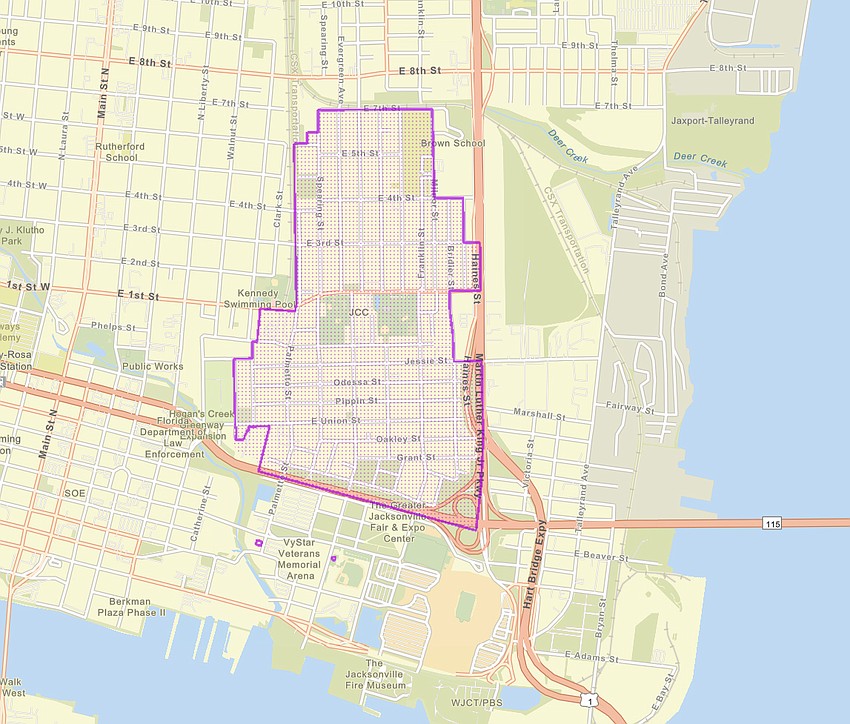
The Eastside neighborhood near EverBank Stadium would gain a larger portion of funding from the city’s community benefits agreement with the Jacksonville Jaguars, but possibly less on a per-year basis than originally anticipated, under action by a City Council panel Aug. 26.
In the last of four scheduled meetings, the Special Committee on the Community Benefits Agreement voted to recommend that the city fully fund the $94 million portion of the CBA that was under review by the committee.
If adopted by the full Council, the committee’s recommendations would provide $40 million in city funding to the Eastside within seven years for workforce development, homelessness services and affordable housing. Another $40 million would go toward those same needs countywide within 33 years.
In addition, $1 million would be provided to each of the 14 Council districts, with the Council members representing those districts given broad leeway in how to spend those dollars.
A compromise deal
The original agreement negotiated by Mayor Donna Deegan’s administration and the Jaguars as part of the "Stadium of the Future" deal to renovate EverBank Stadium called for each side to contribute $150 million.
The city agreed to provide $30 million for the Eastside and $50 million countywide, plus $56 million for development of riverfront parks and the flex field adjacent to the stadium, plus the $1 million per Council district.

The special committee’s vote reflected compromises among members. The original deal called for the city to front-load funding to the Eastside by providing the initial $30 million commitment over three years, which was aimed at kick-starting improvements that would be followed up by $2.5 million per year from the Jacksonville Jaguars beginning in 2028-29.
That proposal drew concerns from committee members that it would put the city budget at risk, coming after a year in which tax revenue came in lower than projected and Council auditors issued projections showing deficits of up to $105 million over the next four years.
Based on those concerns, the special committee stretched the $40 million over potentially more years and also agreed to include several “safety measures” in the entire package that would allow the city to withhold funds in years when city tax collections sag because of poor economic conditions, then make up that funding later.
$4 million a year
Under the committee’s actions, the Eastside would receive at least $4 million per year, with a minimum of $1.5 million per year distributed countywide, unless the Council pauses the payments under certain circumstances.
However, the special committee’s proposed amendments wouldn’t cap the city’s funding on a per-year basis. It’s possible that the $40 million could be paid out in fewer than seven years.

“I think we walked away with a really good deal,” said the special committee’s vice chair, Jimmy Peluso, whose District 7 includes the Eastside. “I think some Council members two months ago would have said we’re definitely not going to spend that kind of money. And instead, we got enough people nodding their heads and saying this is what is in the best interest of the city and of (the Eastside) community.”
In another compromise, the committee agreed to apply to the community benefits agreement nearly $6 million in countywide funding that is poised to be approved for the 2024-25 budget for affordable housing, homelessness services and workforce development. Assuming that funding is approved by City Council as part of the broader budget, the city’s remaining portion of the countywide funding would be $34 million over 33 years.
The changes will require the city to send an amended version of the agreement to the Jaguars for review. Assuming the team approves it, the agreement will then be subject to approval by the NFL owners group along with the overall stadium deal in October.
Plan to pause contributions

Committee members Nick Howland and Will Lahnen pressed for safety measures in what came to be called the “Howland protection amendment,” which allows the city to pause contributions if they exceed the dollar growth in total general fund revenue over the prior year minus either 3% or the Consumer Price Index percentage of the prior year’s budget. The city would be responsible for making up for the lost contribution. For each year the city withheld its funding, a year would be added to the agreement.
Howland said the mechanism ensures the city can fund its core operations first and also protect city finances in a down year.
“As an administration, as a community and as a City Council, we are making a policy that these areas – investment in the Eastside and investment in the categories of affordable housing, workforce development and homelessness – are the future areas that we want to address,” Howland said. “And we will only do so if we have the funding available. Governments love to spend money they don’t have, but we’re not going to do that here.”
Johnson opposed

Council member Rahman Johnson, who is not a committee member but sat in for part of the meeting, said he would work to defeat the amended agreement.
He and committee member Ken Amaro raised concerns over whether the changes to the up-front money for the Eastside would produce meaningful results.
“Forty (million) over seven (years) doesn’t seem like it has that much of an impact,” he said.
Council member Ron Salem, who also was sitting in, urged the committee to devote more of the overall funding to the Eastside.
“To me, this whole process with the CBA began as an Eastside initiative and somehow got broadened to countywide,” he said. “I’d like to see the maximum amount the committee is comfortable with going to the Eastside. I think all of you have driven through there. That’s probably a billion-dollar problem. We can make significant improvements in the next 10 to 20 years.
Peluso said he understood concerns about stretching the Eastside’s funding over more time, but believed the outcome was a “good compromise.”
“We can give all $40 million in three years if we needed to,” he said. “And the minimums we placed in there would ensure that Eastsiders are going to know that at least a certain amount, a certain dollar number, is going to go towards their community every year.”
What's next
The revised agreement is scheduled before the full Council on Sept. 10.
Council President Randy White has committed to creating another committee to discuss the agreement further, including the possibility of establishing a board to direct the funding to specific programs and whether to create a tax increment financing district in the Eastside to generate additional funding.
In TIF districts, funding from future increases in tax revenue due to redevelopment can be used within the district to pay for new infrastructure and programs.